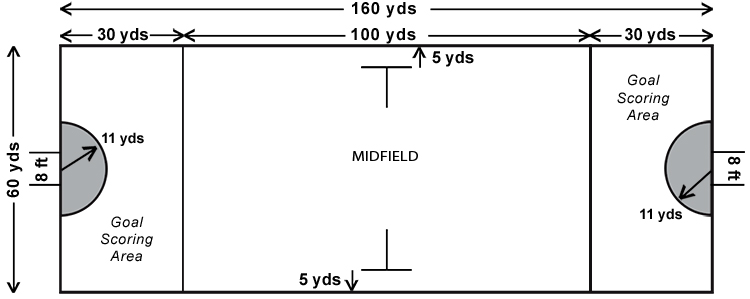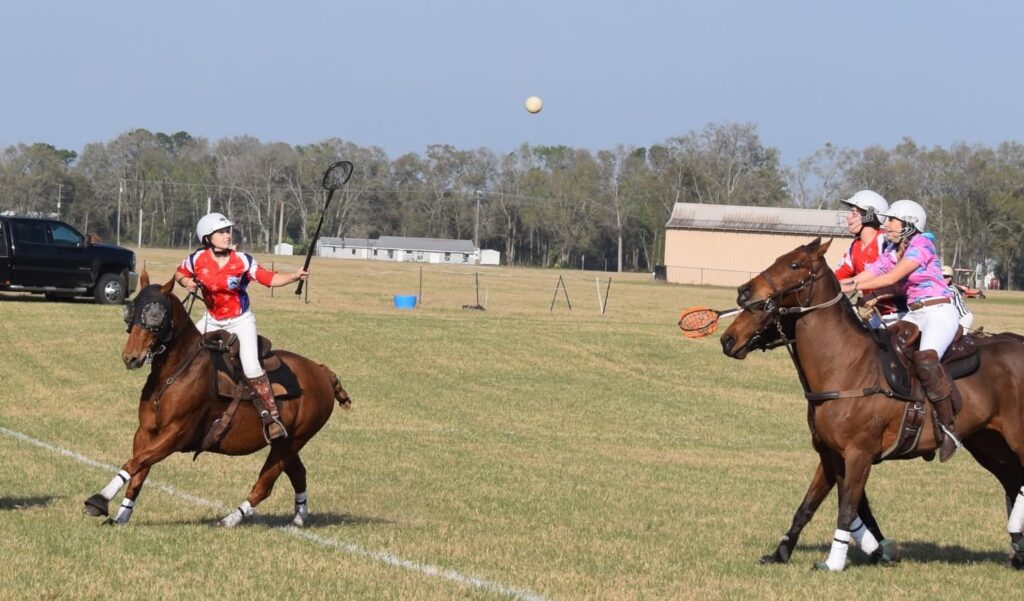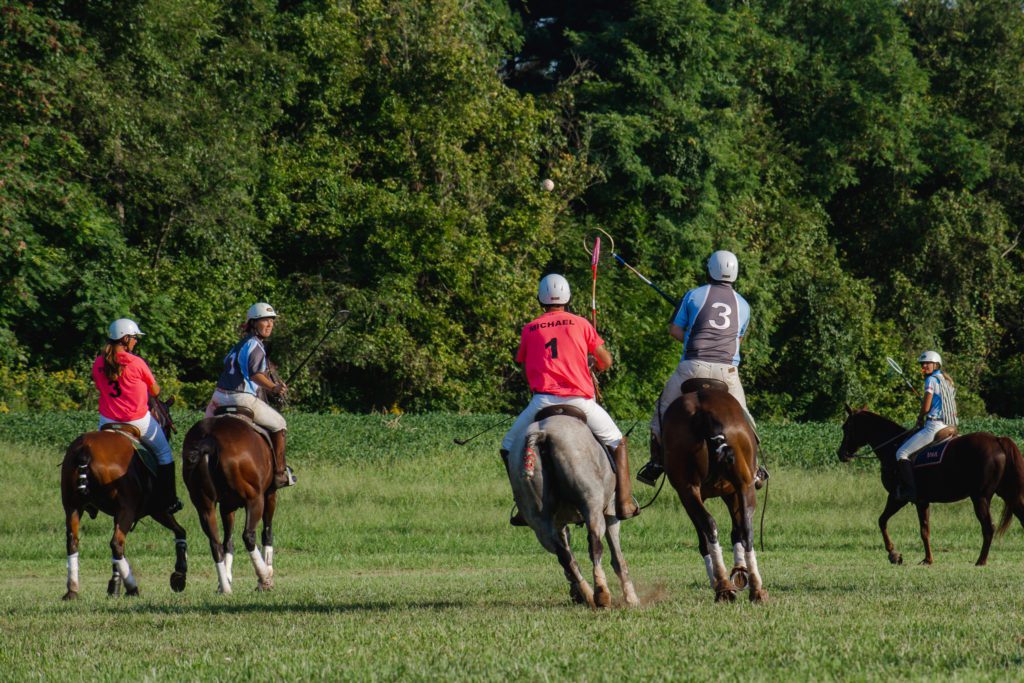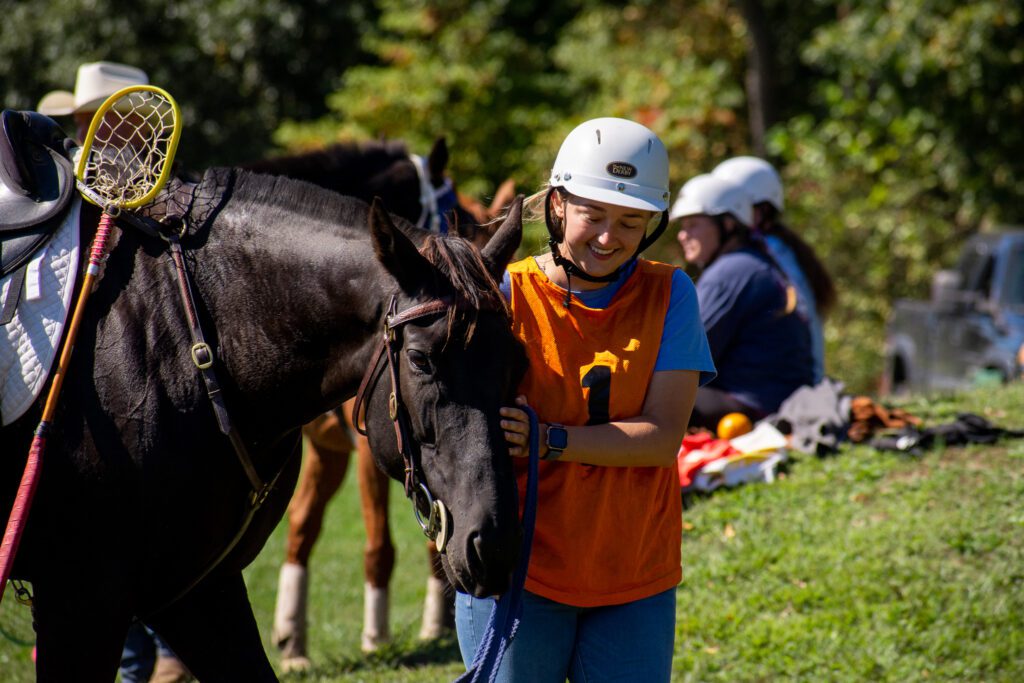Although polocrosse resembles the American Indian game of lacrosse, its origins date back hundreds of years to Persia and its sister sport of polo. In England, polocrosse was an indoor exercise to teach people how to ride a horse. The modern game took shape in Australia in the 1930’s. Today, there are over 6,000 players in the world. For more than 25 years, the United States has had different levels of exchange programs, first beginning with Australia and now includes several other countries. Team USA participated in the first ever Polocrosse World Cup in 2003 and has been in each successive one, held every four years.
How to Play
How to Play Polocrosse: The Game
The polocrosse field can be grass or dirt and is 160 yards long and 60 yards wide. Teams score points by throwing the ball through their opponents goal posts. At the same time, they protect their goal from the other team. All players can catch, carry and throw the ball with their rackets. However, only the player at the number 1 position is allowed to score. The rules are designed with one primary concern, safety — for player and horse. Anything creating a dangerous situation is ruled illegal and is penalized.
Teams and Tournaments
A polocrosse club is a group of people who share an enthusiasm for this thrilling game. A club consists of one more teams playing at various levels of skill, including special teams for those under the age of 21. Teams are comprised of two sections with three players in each. The player who wears number 1 is the primary offensive player and scores the goals. The number 2 is the “swing” player, playing both offense and defense in the middle of the field. The number 3’s job is to defend the goal. The two sections alternate players in six or eight-minute periods or “chukkas.” A typical match consists of four or six chukkas. Players look forward to the weekend tournaments where they compete against teams at their level of play. Tournaments are a time of fellowship, learning and good old-fashioned fun. Join the hundreds of riders across the country taking up this international sport. Polocrosse is for the entire family — boys and girls, moms and dads, everyone from five to 75.
One-Horse Sport
In Australia, polocrosse is called the “King of the One Horse Sports” because a player can use only one horse throughout a tournament. This permits someone who may own only one or two horses to compete at the same level as someone with several. All types of horses play polocrosse: every breed, size and age. Speed, agility, and stamina are desirable, but the only requirement is that a horse be in sound physical condition. Every player should have a polocrosse racket and ball of their own. Helmets must be worn during play. For the horses’s protection, bell boots and leg wraps must be used.
Resources
- All equipment and gear must be sound and in good working order
- Required Equipment
- White pants, matching team jersey with their number clearly marked on the back, riding boots and equestrian approved helmet
- Saddle without a horn
- Breastplate or breast collar
- Protective leg wraps and bell boots on all four legs of playing horses
- Optional Equipment Safety Guidelines
- All whips must have a flap on the end of at least 1 square inch total area
- Bits with shanks, hooks or protruding sidebars are not allowed
- Sharp buckles must be covered
- APA
American Polocrosse Association. The officially sanctioned organization for Polocrosse in the United States of America under the International Polocrosse Council. - Area
The area at either end of the Polocrosse field where the goal posts are positioned. It measures 30 yards long by 60 yards wide and is sometimes referred to as the ‘Goal Scoring Area’ or the ‘End Zone’. - Attack Player
A reference made to the No. 1 player who is the only player allowed to score goals. Plays mid-field and into his goal scoring area. - Back Line
The line located at the end of the Goal Scoring Area, on which goal posts are situated. - Bell
The noise sounded to signify the end of a chukka. Sometimes called the ‘horn’. - Bounce
A technique for crossing the 30 yard line—the ball is thrown to the ground in a forward motion, and retrieved on the other side of the line. - Carnival
In Australia, it is a tournament. In the USA, it has ferris wheels and cotton candy - Carry Over
Traveling over the 30 yd penalty line with the ball in the racquet. - Center Field
The part of the polocrosse field that is between the two goal scoring areas. It measures 100 yards long by 60 yards wide. - Center Line
An imaginary line through the middle of your horse from the poll to the base of the tail. (You may not cross this line with your racquet while in possession of the ball.) - Center Player
The No. 2 player. This individual is only allowed to play in the center field area, and is sometimes called a ‘mid-fielder’, ‘two’, or ‘center’. - Check
The action of reining in your horse to avoid a dangerous situation with another player’s horse. - Chukka
The name for a time period during a Polocrosse tournament. Usually 6 to 8 minutes in length. - Clipping
A foul that occurs when one rider crosses behind another horse so closely that the rear legs of the horse in front entangle with the front legs of the horse in back. - Dangerous Riding
Riding in a manner that creates the potential for injury to horse or rider. - Defense
The team not currently in possession of the ball. - Defense Player
The No. 3 player. This individual acts as a goalie, and tries to prevent the opposing No. 1 player from scoring. - Down Hit
A foul caused by striking at an opponent’s raquet in a downward arc. - Downfield
In the direction of your goal. - Elimination
A tournament format where a team is eliminated from competition if it loses. In an elimination, teams are usually seeded such that the strongest teams play the weakest teams during the early rounds. Also called a ‘Knockout’. - Field
- a verb meaning to enter a team into competition, and;
- a noun referring to the entire 160 by 60 yard playing area
- Foul
An infringement of the rules usually resulting in the fouled side gaining possession of the ball, being awarded a ‘free goal’, or being given an advantage in position when play is resumed. - Free Goal
A goal awarded to a team which has been fouled. Common uses, dangerous riding/dangerous swing. - Free Throw
A throw awarded to a player whose team has been fouled by the opposing team. The umpire marks the spot from which the ball is to be thrown. This throw must travel 10 yards in any direction. It is sometimes referred to as a ‘Penalty Throw’ or a ’10 Yard Throw’. - Game
A match between two teams or sections if the format is a sectional. A game is typically 4 or 6 chukkas long. - Giving Wood
An attempt by a player to knock the ball out of an opponent’s racquet. The swing to strike the opponent’s racquet must be in an upward direction only. - Goal
- The area between the goal posts, and;
- a scored point
- Goal Scoring Judge
A person standing behind the goal posts who determines whether a shot for a goal passes between the goal posts, and whether the No. 1 threw the ball before the horse’s feet cross the ’11 Yard Circle’. Also called a ‘Goal Tender’. - Goal Tender
Same as ‘Goal Scoring Judge’. - Half Court
A variation of the game played on a field with only one goal scoring area; much like half court basketball. - Horn
Same as “Bell.” - International Test Match
Official international polocrosse competition between two teams. - IPC
International Polocrosse Council
- Line of the Ball
This direction the ball is traveling. - Line Up
In midfield, the two opposing sections align themselves in a parallel arrangement, with each pair of No. 1’s, 2’s and 3’s side by side. All players face the side line, with the No. 1’s closest to the line. In the Goal Scoring Area, only the No. 1 and the No. 3 line up, facing the side line. An umpire is positioned outside the side line, facing the players, and throws the ball into the line up to begin play. - Line Up T
A T shaped marking located 5 yards from the side lines at the midpoint of the ‘Center Field’ area. It is the point where players begin each game and where play resumes after a goal is scored. Sometimes called the ‘T’. - Mark
A defensive move to select and isolate one opponent for the purpose of eliminating that player as an effective contributor to the opposing team’s game plan. - Match
A complete game. - Mid-Field
Same as ‘Center Field’. - Mid-Field Player
Same as “Center Player” - Non Stick Side
The side of the player’s body that the ball is carried on. For right handers, it is the left side and for left handers, it is the right side. It is sometimes referred to as the ‘opposite side’ - One on One
A variation of the game with only one player on a side. The player who has possession of the ball in midfield becomes the No. 1; the player who does not have the ball becomes the No. 3. - Penalty Line
The line that separates the Goal Scoring Area from the Center Field Area. This is also called the ‘Line’ or the ’30 Yard Line’. - Penalty Throw
Same as ‘Free Throw’. - Racquet
Stick that carries the ball. - Riding Off
One player rides parallel to an opponent’s horse in an attempt to move the opponent sideways and prevent the opponent’s progression down the field. - Round Robin
A tournament format where every team plays every other team. In a Round Robin, seeding teams is not necessary. - Runout
Ideally, it is a 20 yard clear area surrounding a field which allows running horses a space to slow and stop. - Scorekeeper
The side boundary line of the field. - Section
One half of a standard 6 person team; consisting of a No. 1, a No. 2 and a No. 3. Also called a ‘Side’. - Sectional
A tournament format where three player sections enter rather than full 6 person teams. - Side Line
The line which runs the length of the field from one Back Line to the other, which provides a lateral boundary to the playing field. - Stick
A polocrosse racquet. - Stick Side
The side of a player’s body where the ball is carried in the racquet; the right side for right handers and the left side for left handers. It is sometimes referred to as the ‘Racquet Side’. - Team
6 players make a standard polocrosse team. They are divided into two ‘Sections’ of 3 players each. In a sectional tournament, a team consists of only 3 players. - Ten Yard Rule
In a free throw, no player is allowed to position themselves any closer than 10 yards from the point that the umpire marks as the spot from which the ball is to be thrown - Ten Yard Throw
Same as ‘Free Throw’ or ‘Penalty Throw’. - The “D” or 11 Yard Circle
A semi-circle with an 11 yard radius that is centered on the back line of the Goal Scoring Area, and which encloses the goal posts. Sometimes called the ‘circle or the “D” - Throw In
A ball tossed at shoulder height between the two sections in the line up, which signals the start of play. - Time Out
A period during the game when the clock is stopped. All time outs are called by the umpire. There are no scheduled time outs, such as after a goal or foul. - Timekeeper
The person responsible for timing a chukka, and the individual responsible for sounding the end of the chukka. Also called a ‘Timer’. - Two on Two
A variation of the game with only 2 players; a No. 1 and a No. 3 on a side. - Umpire
The person in charge of the game and the surrounding environment. The umpire’s word is law. - Upfield
In the direction of the other team’s goal. - USPC
United States Pony Club. - Wedging
A foul that occurs when two players on a team squeeze a player from the opposing team between them, causing a dangerous situation. Also called ‘Sandwiching”. - Wild Swing
A foul that occurs when a player swings at an opponent’s racquet on a horizontal plane. Also called a ‘Helicopter Swing’.
Polocrosse Beginner’s Handbook : This handbook is written for the person who wants to try polocrosse. It will support them in preparing themselves and their horse for a fun, safe and a perfect start to ensure success. This is a great tool for instructors, parents, USPC organizers.
Drills Handbook: Proudly brought to you by the Player Development Committee. We hope you find a wide use for this book from structuring
practices, to teaching clinics, to bettering yourself as an individual.




